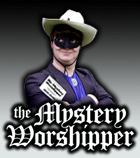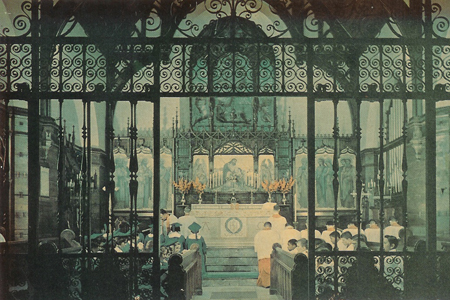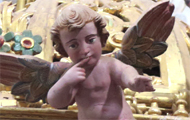| |
 |
 |
 |
| Comment on this report, or find other reports. |
 |
| Our Mystery Worshippers are volunteers who warm church pews for us around the world. If you'd like to become a Mystery Worshipper, start here. |
 |
| Find out how to reproduce this report in your church magazine or website. |
|
|
| 1575: Bethesda
Episcopal, Saratoga Springs, New York, USA |
 |
 |
 |
Mystery Worshipper:
Cassandra.
The church:
Bethesda
Episcopal, Saratoga Springs, New York, USA.
Denomination:
The Episcopal Church, Diocese
of Albany.
Comment: We have received a comment on this report.
The building:
A fortress-like, Gothic gray stone building dating from the
1840s, built on land donated by a local hotel owner who was
received into the Episcopal Church after finding a Prayer Book
left behind by one of his guests. Bethesda's principal architect
was J. Richard Upjohn, noted for his design of New York City's
Trinity Church. The building is replete with motifs of three,
representing the Trinity: three doors leading into the nave,
three windows in each of the transepts, etc. The interior is
extremely beautiful, with a smashing wrought-iron choir screen,
heavy use of carved wood, and outstanding stained glass, some
from the Tiffany studios.
The church:
I was baptized in this church over half a century ago but had
not been there for years. It is one of the largest parishes
in the diocese of Albany, claiming 800 members. They sponsor
a number of social events throughout the year whose focus is
to create an atmosphere of Christian fellowship, and make a
special effort to keep in contact with the sick, shut-in, and
bereaved of the parish. There are three services every Sunday
and a healing service on Wednesdays.
The neighborhood:
Saratoga Springs is a city in the easternmost part of New York
State, about halfway between New York City and the Canadian
border. From colonial times it was well known for its mineral
springs, thought to have medicinal properties. The church's
name was derived from the healing waters described in the gospel
of John (John 5:2-4). During the 19th and well into the 20th
century, people flocked to Saratoga for its mud baths, waters
(for drinking as well as bathing), and (after the bath) horse
racing. I remember the throngs of people who descended on Saratoga
every August when I was a teenager, largely for gambling and
racing. Saratoga's glory days are long gone, but people still
visit for the horse races and spa treatments, and bottled Saratoga
drinking water with its crisp, slightly sweet taste has a loyal
following. There is also a vibrant night life – Bob Dylan
and Arlo Gurthrie have both performed in Saratoga, and it is
said that singer Don McLean wrote his hit song American
Pie while sitting in a bar on Caroline Street. Saratoga
Springs is home to the prestigious, elite Skidmore College.
The cast:
The Revd Thomas T. Parke, rector; the Revd Paul Evans, priest
associate; Farrell Goehring, organist and director of music;
Anthony Holland, Mus.D., choral director.
The date & time:
Palm Sunday, March 16, 2008, 10.00am.
What was the name of the service?
Liturgy of the Palms and Mass of the Passion.
How full was the building?
Almost completely full. I estimated between 150 and 175 people.
Did anyone welcome you personally?
A very pleasant "Good morning!" from two people handing
out bulletins.
Was your pew comfortable?
Yes. Nice cushions and comfortable back rests.
How would you describe the pre-service
atmosphere?
Some quiet conversation but overall a feeling of expectation
and anticipation.
What were the exact opening words of the
service?
"Let us pray." A tasteful change from the "Welcomes" or
"Good mornings" or "Howdys" too often heard
elsewhere.
What books did the congregation use during the
service?
The Prayer Book and 1940 Hymnal were available.
There was also a handout – a little crowded, perhaps (maybe
they were trying to save paper?), but functional.
What musical instruments were played?
Organ and four French horns (on loan from Skidmore, I believe).
There was also a very good choir of about 20 singers.
Did anything distract you?
A child made a few modest little noises which couldn't hold a candle to some of the outbursts I have heard in other places.
Was the worship stiff-upper-lip,
happy clappy, or what?
I would call it relaxed Anglo-Catholicism at its best. Incense,
gong (not bells), proper genuflections and elevations. No strange
bizarre arrangements. The ordinary was the Missa Simplex,
which I thought at first would be rather stark, but the organist
provided a beautiful accompaniment. There were two motets at
communion: one by Anton Bruckner and another by the late renaissance
Italian composer Giovanni Francesco Anerio – both lovely.
Exactly how long was the
sermon?
12 minutes.
On a scale of 1-10, how good was the preacher?
10 – Actually, off the scale. Father Parke spoke without notes,
from the pulpit, as an abbott might speak to his order. Unhurried,
distinct delivery, unaffected. If only all sermons could be
so good.
In a nutshell, what was the sermon
about?
He contrasted the joy of Palm Sunday with the somber atmosphere
of Holy Week. He compared Jesus' silence to modern trials, where
it seems that nobody ever stops talking. How awful it is to
be punished when you are innocent. He made a quick reference
to the legal troubles of New York's former governor Eliot Spitzer,
who appeared to be guilty of his crimes. When bad things happen
to us, the example of Jesus can get us through them. "Come
down from the cross," Jesus' scoffers cried. But Jesus
did better than that.
Which part of the service was like being in
heaven?
Where to start? The grand building, the great preaching, the
wonderful liturgy, enthusiastic congregational singing – where
indeed!
And which part was like being in... er... the other place?
I can find only slight fault with two aspects of the mass. No
hymn numbers were given, which meant that if we didn't already
know the hymns we literally had nowhere to turn. And I like
to sing the bass part. Also, there was no Anglican chant. What's
an Anglican service without the beautiful chant so characteristic
of our liturgy?
What happened when you hung around after the service looking lost?
Not much. Several people smiled and said hello, and the rector
was extremely cordial at the door, but that's about it.
How would you describe the after-service
coffee?
No announcement had been made, but I found my own way to the
reception. Coffee, tea and juices were available – no wine
or anything stronger. There were also some very acceptable finger
foods: cake, cookies, etc. The rector came and sat with me for
a bit.
How would you feel about making this church your regular (where 10 = ecstatic, 0 = terminal)?
10 – Definitely.
Did the service make you feel glad to be a
Christian?
Very much so. This is clearly a parish in which there is no
gossiping, backbiting or any other underhanded maneuverings.
How do I know? You can sense things like that, and that was
my sense.
What one thing will you remember about all this in seven days' time?
Strangely, the closing hymn: "O sacred head now wounded."
I knew where that one was in the hymnal, and what a treat it
was to be able to sing the bass line! |
|
|
 |
 |
 |
| We rely on voluntary donations to stay online. If you're a regular visitor to Ship of Fools, please consider supporting us. |
 |
 |
 |
| The Mystery Pilgrim |
 |
| One of our most seasoned reporters makes the Camino pilgrimage to Santiago de Compostela in Spain. Read here. |
 |
 |
 |
| London churches |
 |
| Read reports from 70 London churches, visited by a small army of Mystery Worshippers on one single Sunday. Read here. |
| |
|
|
|
|


